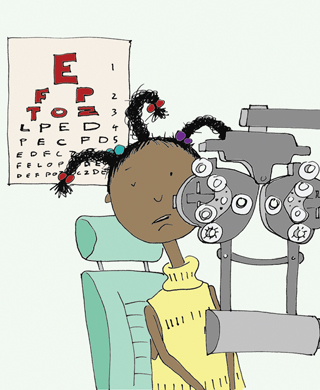Illustration by Andrea and Pete Connolly
A few years ago, I was touring a ruined abbey in Scotland. In a small museum containing objects found in excavations of the site were a pair of eyeglasses worn by monks in the 13th century.
The relationship between vision and reading is not exactly news. Since most adults eventually need reading glasses, most people reading this blog probably have personal experience with the transformational impact they can have.
Along with colleagues at the Johns Hopkins Hospital's Wilmer Eye Clinic and the Johns Hopkins School of Education, we are doing a study of the relationship between vision and reading in inner-city schools in Baltimore. Our project is not finished, so I can't report on all aspects of our findings. But what we have found so far is profoundly disturbing.
We are giving comprehensive vision tests to second- and third-graders in some of the most impoverished schools in the city. We are finding high rates of visual impairment, which can be corrected by eyeglasses. Yet only 1 to 3 percent of the children have glasses in school.
The state of Maryland requires vision screening in first grade, and many of these children were found to need glasses previously. Yet a hundred things go wrong in getting glasses on kids' faces in inner-city schools. Some kids are missed in the screening. Those who are identified get a letter sent to the parents, who may or may not follow up. Some cannot afford glasses, while others qualify for assistance to purchase glasses but do not know how to go through the procedures to get them. Glasses frequently get broken or lost or stolen, and there are no procedures to replace them. As a result, few kids who need them have glasses in school, even just one year after the screening year.
A key factor in all of this is that vision is seen as a health problem, not the school's problem. Schools do not have resources for eyeglasses, so even though they are accountable for children's reading, and even though school leaders and teachers know full well that a lot of their kids just need glasses, they feel helpless in solving this simple problem. Title I funds, for example, cannot be used for glasses. The result is that many children are receiving very expensive remedial services, tutoring, or special education, when a $20 pair of glasses would actually solve the problem.
In our project, we are testing kids, and, for those who need them, we are providing two pairs of glasses, one for home and one for school. Teachers are given craft boxes to hold the glasses and facilitate distributing them each day. If glasses are broken, they are replaced. Eyeglasses are in these days, and the kids are very proud of their glasses. Compared with other interventions for struggling readers, the cost of a few pairs of glasses is trivial. Not every struggling reader is struggling due to poor eyesight, but imagine if 20 or 10 or even 5 percent of children in high-poverty schools are struggling in reading or other subjects due to vision problems that are easily remediated with ordinary eyeglasses.
I'm always reluctant to get ahead of the data, but imagine for a moment what it would mean if we do find that significant numbers of inner-city kids are failing year after year just because they lack glasses. Hopefully, this finding would lead to government and private programs throughout the U.S. providing eyeglasses in schools and giving teachers and administrators responsibility to see that children receive and use their glasses. This could make a huge difference in one easily recognizable subgroup of struggling readers.
At a larger level, think what such a finding might say about poverty and education. Educators naturally seek educational solutions to educational problems in high-poverty schools, reasoning that they cannot solve problems of housing, crime, unemployment, and so on. Yet there may be some non-educational interventions that they could use to improve student outcomes. What matters is the outcomes, and it is crucial that proven solutions be allowed to cross traditional boundaries if they require it.
At a larger level still, consider how families get into poverty in the first place. How many kids with poor eyesight fail in school, lose motivation, and ultimately lose access to positive futures? How many impoverished parents were once children with poor eyesight, or other easily solved health difficulties? How many inner-city communities suffer from having many young people who perceive no hope due to reading difficulties that could have been prevented?
Eyeglasses are not new, and they are not magic. Yet they may well be part of a solution to fundamental and persistent problems of education.

